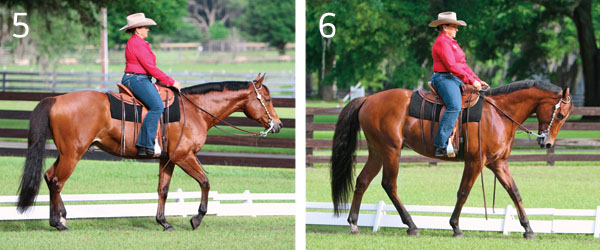Your horse’s balance and frame—and the tempo and cadence created from them—play an integral role in Western dressage, as well as in the specialized gaits and way of going required in ranch riding.
[READ: SLOW DOWN A FAST LOPE]
A horse in uphill balance, with his poll above his topline and his hind end engaged and driving forward, is happier and more comfortable. You can see those characteristics in my horse’s expression: his eyes are focused on where he’s going, his ears are forward, and his natural tail carriage swings from left to right with his stride.
Here, I’ll discuss my horse’s balance, frame, and tempo in six different photos to help you better understand the relationship between these traits and my horse’s way of going, as well as his attitude. Keep these thoughts in mind the next time you ride.
1. My horse shows the balance and frame of an advanced level in Western dressage here. It’s pretty ideal. He’s traveling in uphill balance, with his poll above his withers; his weight in his hindquarters; and strong engagement from his hind legs drives him forward. This allows him to travel with correct tempo—his two-beat working jog has fluidity, and he’s light on his feet, which is created from his forward motion. His natural tail carriage helps with his balance. He’ll maintain this frame and tempo because it’s natural for him, rather than being forced to manufacture a false body position.

2. Here you see a good Western jog, one that’d do well in a ranch riding class or in the introductory and basic levels in Western dressage. You can see that my horse is in a longer frame through his body; his nose is just out past being vertical to the ground. Even so, he maintains perfect tempo and cadence, thanks to the impulsion from his hind end.
3. This is a good example of a second- or third-level collected jog in Western dressage. My horse is more collected than in Photo 2, and you can see that there’s more animation and height in his legs. It’s also an excellent body position to prepare for a stop in ranch riding, since the class’ rules don’t allow sliding stops. It also allows you to do the maneuvers required in the advanced level of Western dressage.

4. I admit that the horse’s legs aren’t in the best position here, as the photo was taken between beats in the jog. Still, this is an example of a free jog in Western dressage. After working on collection, the horse needs to stretch his back muscles and the rest of his body. I give him more slack in my reins, and he automatically lowers his head and neck to stretch the muscles he used to collect his body. Western dressage calls for this gait at both the walk and jog.
5. There’s an obvious lack of collection here. I’m just a passenger on top of my lazy horse, rather than actively riding him and getting him into an effective frame. You can easily see that his hind end isn’t engaged; he’s pulling along with his front end rather than driving from behind. He can’t travel with any roundness to his spine when pulling himself forward.

6. Remember my horse’s happy expression in Photo 1? That’s gone now. I’ve blocked my horse’s forward motion with my hands, which makes his face go behind the vertical. He’s also lost his drive from behind. His tense eyes, ears, and jaw say he’s not happy, so he resists or tries to escape. The tempo will always vary in this position. It’ll never be steady.
Lynn Palm, Ocala, Florida, has provided sound horsemanship advice to riders of all disciplines for more than 40 years. With her husband, Cyril Pittion-Rossillon, Palm conducts clinics across the U.S. and abroad, as well as at their own Fox Grove Farm. Learn more at lynnpalm.com.






